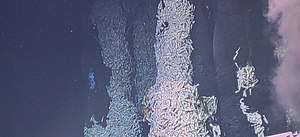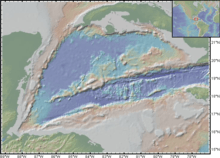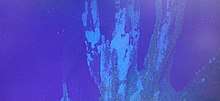Beebe Hydrothermal Vent Field
The Beebe Hydrothermal Vent Field (also known as the Piccard Vent Field) is located just south of Grand Cayman in the Caribbean, on the north side of the Mid-Cayman Spreading Centre in the Cayman Trough.[1] Approximately 24 kilometres (15 mi) south of Beebe is the Von Damm Vent Field.
| Beebe Vent Field (BVF) | |
|---|---|
| A series of vents on the Mid-Cayman Spreading Center. | |
 Tall sulfide chimneys covered in shrimp. | |
.svg.png) | |
| Location | Mid-Cayman Rise |
| Coordinates | 18°32′48″N 81°43′6″W |
| Area | 22,050 square metres (237,300 sq ft) |
| Max. elevation | −4,957 metres (−16,263 ft) |
| Min. elevation | −4,987 metres (−16,362 ft) |
At nearly 5,000 metres (16,000 ft) below sea level, Beebe is the world's deepest known hydrothermal vent site and one of the few known to reside in the abyssopelagic.[2] The hydrothermal plume nicknamed "Piccard" was identified was detected in 2010,[3] and the Beebe site was discovered later that year.[1] The vent field hosts two main areas of black smoker venting, with a fluid at temperatures of over 400 °C and a low salinity of about 2.3 wt% NaCl. Under these conditions, the venting fluid is supercritical at the vent orifice,[4][5] and is the only site shown to host sustained supercritical venting. The combined depth and vent fluid temperature make it a popular site for studying aqueous thermodynamics, high-pressure biology, and geochemistry.
Geography

The Beebe vent field is located at the northern end of the Mid-Cayman Rise on the segments closest to the Septentrional-Oriente fault zone. The entirety of the field resides on the western side of the axial valley.[6]
The Beebe vent field consists of 7 sulfide mounds, the majority of which are inactive.[7] Central to the field are the main endmember vents, known as Beebe 1 - 5 which branch from the same mound. Surrounding these endmember vents are Hot Chimlet to the north, Beebe Sea to the East, and Beebe Woods to the South. The series of mounds continue to the northeast of the field, where high-temperature hydrothermal activity used to take place as evidenced by extinct chimneys.[8]
Geology
The Beebe vent field is located in the very near vicinity of the spreading center, which has been described as an ultraslow ridge at a rate of 15 millimetres (0.59 in) to 16.9 millimetres (0.67 in) per year. The area is primarily basalt, with metal-sulfide mounds and talus sourced from hydrothermal activity.[8]
Chimneys

Beebe vents 1 - 5 form a branching complex consisting of pyrite, pyrrhotite, and other oxidized metal-sulfides. These chimneys emit the hottest temperature fluids of anywhere within the field, up to 403 °C (757 °F).[7] Beebe Woods to the south has a similar geological composition, though temperatures are cooled slightly (354 °C (669 °F)). These temperatures are hot enough that iron has not yet precipitated, giving the chimneys a distinctive black-smoker appearance. These metal-sulfide chimneys are conductive of precious and semi-precious mineral precipitation, such as gold, silver, and copper.[9]
Hot Chimlet to the north features venting at a significantly lower temperature (149 °C (300 °F)), such that the fluids are clear and devoid of metals. Residing on the slope of the mound, the Hot Chimlet site has a light dusting of sulfide materials likely sourced from the center of the field. Hot Chimlet also does not have the impressive chimney structures as at the center of the field, and requires the use of dive markers to identify quickly. Shrimp Gulley, similarly, is a location within the Beebe Sea which is distinguished by abundant biology. The Gulley reaches temperatures around 45 °C (113 °F), with markers also required to find the exact locations of diffuse flow.

Chemistry
As with many basalt-hosted systems, Beebe has endmember fluids that are highly acidic in association with basalt dissolution reactions. Such reactions with basalt can be favorable in forming hydrothermal ore deposits.[10]
Extreme temperatures and depth are favorable conditions for phase separation, such that measured amounts of chlorine are depleted relative to seawater (similarly to the Rainbow Vent Field on the Mid-Atlantic Ridge). These hot, acidic conditions make precipitation of metal-sulfide chimneys possible, also giving the hottest vents their characteristic black-smoker appearance.
Organic compounds
With abundant iron in the venting plume, there have been many models examining the potential of ligands binding to iron when mixing begins with seawater. These ligands prevent the precipitation of iron in mineral phases, potentially making them bioavailable.[11]
High temperatures acting on seawater can cause diagenesis of organic compounds, such that they break up into smaller compounds or alter bond configurations.
Biology
Beebe has an abundance of shrimp present at venting orifices, particularly those of Rimicaris hybisae, belonging to the family of Alvinocarididae, and are almost completely blind.[12] These shrimp have eyes as jouveniles but lose them as they age, developing a light-sensing organ that they can use to detect the infrared glow of hot, venting locations.[13] The shrimp at the Beebe vent field are unique from those found at the Von Damm field in that they are a slightly more brown color due to the high concentrations of iron pumped out by the vents.
There is also an abundance of deep sea anemones and solitary squat lobsters.[14] As with other vent fields, it is possible for sharks or roaming fishes such as grenadiers or wreckfish to appear around the field.

From a microbial standpoint, there are visible mats of microbial activity at both the Beebe and Von Damm vent systems. Microorganisms are suggested utilize hydrogen and sulfide in venting fluids to metabolize chemosynthetically.[14] Some of these microorganisms are present on or within vent crustaceans, being routinely grazed or taking up roles as symbiotic organisms.
Naming
The hydrothermal system was suggested to exist on an American-led oceanographic cruise in 2009 on the R/V Cape Hatteras, with 3 hydrothermal plumes detected in the water column: Piccard, Walsh, and Europa.[3][15] Beebe was visually confirmed in early 2010 on a British-led expedition with the RRS James Cook, though the Piccard plume could not be found, so the vent field was named Beebe. Americans returned to the vent field in 2011 on the Okeanos Explorer prior to scientific publications from the previous mission, and named the vent field Piccard, therefore creating a second name for the vent field.[16] The Interridge Database lists the vent field as Beebe, though many American journals publish results under the name of Piccard.
The original name for the detected plume, Piccard, may come from Jacques Piccard, a Swiss oceanographer that dove with Don Walsh to the Challenger Deep. The subsequent naming of Beebe is after the American naturalist William Beebe who frequently dove in the Bathysphere prior to powered submersibles.[17]
Jurisdiction
Due to the nearness of Beebe to the Cayman Islands, the vent field falls under British jurisdiction.
External links

References
- Connelly, Douglas P.; Copley, Jonathan T.; Murton, Bramley J.; Stansfield, Kate; Tyler, Paul A.; German, Christopher R.; Van Dover, Cindy L.; Amon, Diva; Furlong, Maaten; Grindlay, Nancy; Hayman, Nicholas; Hühnerbach, Veit; Judge, Maria; Le Bas, Tim; McPhail, Stephen; Meier, Alexandra; Nakamura, Ko-ichi; Nye, Verity; Pebody, Miles; Pedersen, Rolf B.; Plouviez, Sophie; Sands, Carla; Searle, Roger C.; Stevenson, Peter; Taws, Sarah; Wilcox, Sally (10 January 2012). "Hydrothermal vent fields and chemosynthetic biota on the world's deepest seafloor spreading centre". Nature Communications. 3 (1): 620. Bibcode:2012NatCo...3..620C. doi:10.1038/ncomms1636. PMC 3274706. PMID 22233630.
- Beaulieu, Stace E.; Baker, Edward T.; German, Christopher R.; Maffei, Andrew (November 2013). "An authoritative global database for active submarine hydrothermal vent fields: GLOBAL VENTS DATABASE". Geochemistry, Geophysics, Geosystems. 14 (11): 4892–4905. doi:10.1002/2013GC004998. hdl:1912/6496.
- German, C. R.; Bowen, A.; Coleman, M. L.; Honig, D. L.; Huber, J. A.; Jakuba, M. V.; Kinsey, J. C.; Kurz, M. D.; Leroy, S.; McDermott, J. M.; de Lepinay, B. M.; Nakamura, K.; Seewald, J. S.; Smith, J. L.; Sylva, S. P.; Van Dover, C. L.; Whitcomb, L. L.; Yoerger, D. R. (21 July 2010). "Diverse styles of submarine venting on the ultraslow spreading Mid-Cayman Rise". Proceedings of the National Academy of Sciences. 107 (32): 14020–14025. Bibcode:2010PNAS..10714020G. doi:10.1073/pnas.1009205107. PMC 2922602. PMID 20660317.
- Webber, A.P.; Murton, B.; Roberts, S.; Hodgkinson, M. "Supercritical Venting and VMS Formation at the Beebe Hydrothermal Field, Cayman Spreading Centre". Goldschmidt Conference Abstracts 2014. Geochemical Society. Archived from the original on 29 July 2014. Retrieved 29 July 2014.
- Shukman, David (2013-02-21). "Deepest undersea vents discovered". BBC News. Retrieved 2020-05-19.
- Van Avendonk, Harm J. A.; Hayman, Nicholas W.; Harding, Jennifer L.; Grevemeyer, Ingo; Peirce, Christine; Dannowski, Anke (June 2017). "Seismic structure and segmentation of the axial valley of the Mid-Cayman Spreading Center". Geochemistry, Geophysics, Geosystems. 18 (6): 2149–2161. Bibcode:2017GGG....18.2149V. doi:10.1002/2017GC006873.
- McDermott, Jill M.; Sylva, Sean P.; Ono, Shuhei; German, Christopher R.; Seewald, Jeffrey S. (May 2018). "Geochemistry of fluids from Earth's deepest ridge-crest hot-springs: Piccard hydrothermal field, Mid-Cayman Rise". Geochimica et Cosmochimica Acta. 228: 95–118. Bibcode:2018GeCoA.228...95M. doi:10.1016/j.gca.2018.01.021.
- "Beebe | InterRidge Vents Database Ver. 3.4". vents-data.interridge.org.
- Webber, Alexander P.; Roberts, Stephen; Murton, Bramley J.; Mills, Rachel A.; Hodgkinson, Matthew R. S. (June 2017). "The formation of gold-rich seafloor sulfide deposits: Evidence from the Beebe hydrothermal vent field, Cayman Trough: GOLD IN THE BEEBE VENT FIELD". Geochemistry, Geophysics, Geosystems. 18 (6): 2011–2027. doi:10.1002/2017GC006922.
- Yardley, Bruce W. D.; Cleverley, James S. (2015). "The role of metamorphic fluids in the formation of ore deposits". Geological Society, London, Special Publications. 393 (1): 117–134. doi:10.1144/SP393.5. ISSN 0305-8719.
- Sander, Sylvia G.; Koschinsky, Andrea (20 February 2011). "Metal flux from hydrothermal vents increased by organic complexation". Nature Geoscience. 4 (3): 145–150. doi:10.1038/NGEO1088.
- "Expedition journeys into world's deepest hydrothermal vents". NBC News. Retrieved 2020-05-19.
- "Eyeless Shrimp Discovered at Deepest Volcanic Vents". livescience.com.
- "Researchers marvel at world's deepest sea vents". www.cbsnews.com. Retrieved 2020-05-19.
- "Rolling Deck to Repository (R2R)". www.rvdata.us. Retrieved 2020-02-12.
- "Mid-Cayman Rise Expedition 2011: NOAA Office of Ocean Exploration and Research". oceanexplorer.noaa.gov. Retrieved 2020-02-12.
- "Two new hydrothermal vent fields discovered". University of Bergen. Retrieved 2020-02-12.